How alligators are breathing life into Florida's Everglades
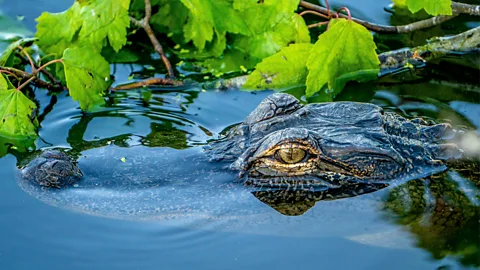 Alamy
AlamyThe Everglades' eclectic alligators are surprisingly diverse builders, bodyguards, commuters, and health-bringing engineers.
From the edge of the Miccosukee Indian Reservation, in the north of the Florida Everglades, it is a short fan-boat ride through grassy swamp to get to an island that 18-year-old Hector Tigertail's family visit each year. For decades, this family "hammock" – as the tree-covered islands that poke out from the Everglades are known – has been their retreat; a place where the family can camp, cook and hunt. But they share this particular island with at least one permanent resident: an American alligator that, at around 7ft (2.1m) from nose to tail, is the largest female he's ever seen.
Tigertail's family, members of the Miccosukee Tribe of Indians of Florida, and this powerful reptile, which locals refer to as Mama Gator, have lived side by side for much of the 60-year-old animal's life, he explains. This intimate coexistence provides a chance to observe how alligators meticulously shape their surroundings. Through the dry season between December and May, she excavates a "gator pond" with her snout, claws and tail, a depression where water pools and she can wallow, keep cool and mate. At the start of the rainy season (from June to November), she builds a raised nest for her clutch of eggs, from mud, grass and twigs – a time when the humans know to keep a respectful distance from the protective mother. In return, for the next few years, they are often rewarded with the sight of Mama and her baby gators in tow.
"We like to call her Mama Gator because she's everybody's grandma," says Tigertail.
In recent years, scientific research is adding support to something Florida's Miccosukee Tribe have long known: alligators like Mama play vital roles as "guardians of the Everglades" and engineer their environment in ways that protect freshwater ecosystems. Alligators carry around nutrients that feed ecosystem webs, and their ponds and nests provide refuges where plants, fish and frogs live. New data hints that that alligators may also benefit us.
"Apex predator or not, alligators are actually very helpful and they can change the ecosystem significantly," says Tigertail, who researches alligators for the Miccosukee Tribe's Fish and Wildlife Department. "During the dry season, a lot of animals – deer, fish, otters, turtles, birds – follow the alligators."
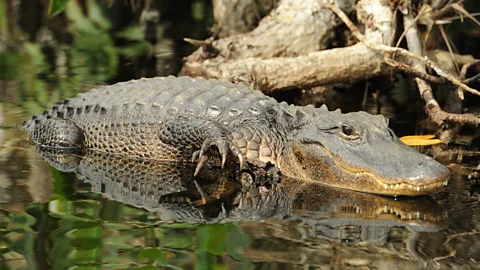 Hector Tigertail
Hector TigertailFor those like biologist Christopher Murray who has spent decades closely studying alligators, it's high time to move past their reputation as cold-hearted killers and recognise the varied roles they're playing as caring and constructive ecosystem engineers. While the cute, herbivorous beaver is widely celebrated for stewarding temperate wetlands, it is the "gnarly swamp monsters" who deserve plaudits in the southeastern United States and many other places, says Murray, associate professor at Southeastern Louisiana University. "I think we're just beginning to understand that crocodilians, in general, and specifically alligators, do a lot more good than we think."
From near-extinction to mass appreciation
Alligators are often called "living fossils", relatively untouched by major evolutionary changes for at least eight million years, with remarkably similar ancestors already hunting swamps alongside the dinosaurs. Yet, beginning in the 1850s, the arrival of rifle-wielding European settlers into the wetlands of Florida and Louisiana drove this evolutionary line to the verge of extinction.
More than 10 million alligators were killed by commercial hunting up to the 1960s, driven by the popularity of their hides for bags, belts and boots, with others shot for sport or "just for fun" according to historical accounts. In 1967, American alligators were placed on endangered species lists, leading to nationwide hunting bans that allowed populations to recover. Today, the species is recognised as a standout conservation success story, as the population has rebounded to more than three million alligators estimated to live in the wild in the states of Florida and Louisiana, and thousands more spread across the south-eastern United States.
Just as conservationists began fighting to save the species from extinction in the 1960s and 1970s, researchers began documenting their important ecological roles. In the wet season, the raised ridges around the edge of these nests are relatively dry land where some plants can escape flooding and provide platforms where smaller reptiles build their own nests. Meanwhile wading birds build their own nests above alligators, which act as "bodyguards", keeping raccoons and other predators away from the birds' eggs. (More recent research has shown that this is a macabre but overall mutually beneficial arrangement with alligators being rewarded with snacks from chicks that fall from the nests.)
Carbon Count
The emissions from travel it took to report this story were 0kg CO2. The digital emissions from this story are an estimated 1.2g to 3.6g CO2 per page view. Find out more about how we calculated this figure here.
Mike Heithaus, professor of biological sciences at Florida International University, explains that, despite its lush appearances, the Everglades can be a nutrient poor environment. A largely flat wetland, dominated by grass-like plants, many key nutrients are carried out to sea by great slow-flowing seasonal rivers, some kilometres wide.
In the dry season, when the water level falls, research since the mid-20th Century has shown that alligators' habit of excavating holes created variety in the otherwise monotonous landscape, with unique communities of plants, animals and algae around ponds. These holes can be architecturally diverse – created by one alligator or up to a dozen together – incorporating eclectic "burrows and hidey-holes", says Heithaus, including underwater caverns, where the alligator can stay submerged for hours. These aquatic environments form refuges in which fish like juvenile largemouth bass survive the dry season but can also be "death traps" which lure birds in search of a snack, he adds.
We're now learning these are surprisingly dynamic systems. Research in 2023 showed that it was not only the construction of the ponds that counted "but actively being in the pond matters", says Heithaus. As the alligators move, they continually stir up the sediment to keep those nutrients in the water. "The alligators are moving around; they're pooping in there. That's providing nutrients which algae – that form the base of the food web – rely on. So, you kind of prime the pump: you feed the bottom of the food chain and [the nutrients] come all the way up."
Without alligators, there would be much less nutrients circulated in the water, says Heithaus. "You put alligators there, and you get food and water, and that's happy times for most critters in the Everglades."
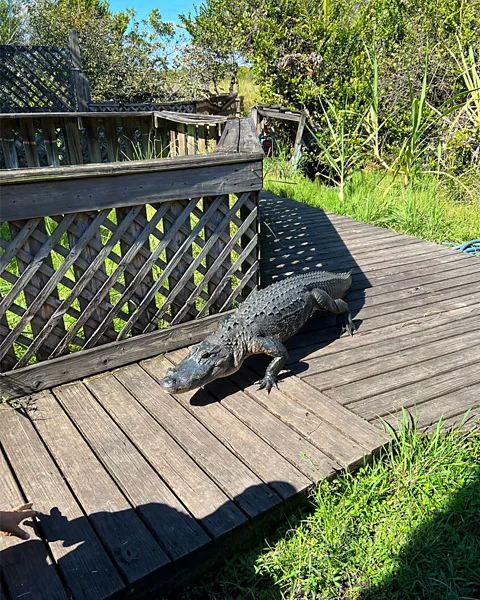 Hector Tigertail
Hector TigertailEclectic alligators
This research also reveals a lesser-seen side of alligators, spotlighting them as remarkably sophisticated and adaptable creatures. The alligator's reputation as a "man-eating monster" was inspired long ago by accounts like William Bartram's widely reproduced (and wildly inaccurate) stories of encountering alligators in Florida swamps with "clouds of smoke" erupting from their nostrils. Although attacks on humans are very rare, these cold-blooded animals remain feared by many as killers or "weird swamp things", says Murray, who has worked with alligators for more than two decades.
Those who live up close with alligators see other qualities. One alligator in the state of Georgia, named Wally, was even docile enough to be domesticated as an "emotional support alligator", providing comfort and "hugs" to help alleviate his owner's depression.
Despite the reported gentleness of some individuals, it is recommended to stay at least 9m (30ft) away from alligators in the wild. Alligators are carnivores, powerful enough to bring down a wild deer or feral boar but "naturally they're going to be more of a flighty, non-confrontational animal," says Kendall Osceola, who worked at the Miccosukee Indian Village, the tribe's cultural centre. The Miccosukee learn a strict set of rules from a young age for sharing their coastal homes with gators. "We were always told if there's a body of water in Florida, there's going to be an alligator in there. So, keep a careful eye on any pets or anything small around the water line," she says. Yet Miccosukee stories depict them as "benevolent creatures", she says.
More like this:
Today, alligators have adapted to live in the urbanised environments of golf courses, canals and sewers. Researchers have been surprised by how varied and flexible alligators are, explains Heithaus, yet research in 2011 found behaviours that have shocked even those who study them. Near Miccosukee village, in an area where alligators live in mangrove forests alongside a fast-flowing river, Heithaus and Adam Rosenblatt fitted trackers to alligators, finding that similar alligators lived very different lives – some were "couch potatoes" who remain close to home, while others were "commuters" who travel long distances to coastal areas. "Tag two alligators – same size, both males, 20m (65.6ft) apart on the shore – and one will not move more than 7km (4.3 miles) in total in three months, and the other might do 800km (497 miles)," says Heithaus.
While American alligators have been spotted swimming out in the ocean in the past, prior to this research this behaviour was believed to be extremely rare, says Heithaus. Unlike crocodiles, alligators lack specialised glands to process salt, yet this monitoring showed that some alligators frequently venture out into the ocean when there are abundant saltwater fish and crabs to feast on. "When we first got some data suggesting the alligators were down in these saltwater environments for maybe 18 hours at a time, we were looked at like we had two heads – people didn't believe it at all," says Heithaus. "And I think it's one of the cool things we're finding across sharks, alligators, and lots of animals – that there's a lot more behavioural adaptability and individual specialisation than we would have thought – bold individuals, shy individuals; exploratory individuals, stay-at-home individuals."
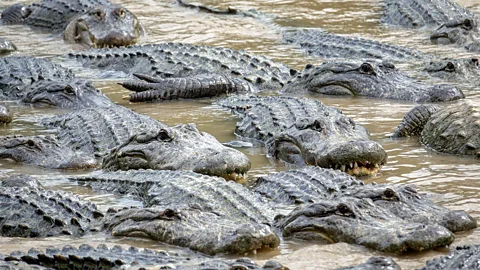 Alamy
AlamyCarbon-consuming monsters
Heithaus is aiming to figure out what causes these different behaviours – whether genetic or influenced by environmental factors – as well as what role "commuting" plays in cycling nutrients around wetland environments. Already, studies have shown that alligator ponds are richer in key nutrients like phosphorus and commuters are carrying nutrients up into the wetlands from coastal areas, by eating in the oceans and excreting upstream. "We know that they're moving these nutrients upstream," says Heithaus. His team at the Florida Coastal Everglades Long Term Ecological Research Program is seeking a more granular understanding of how this affects the overall "nutrient budget" of the ecosystem, where nutrients are deposited, and how it affects the overall system.
Crucially, at a time when the Gulf Coast is being hard hit by the impacts of climate change, we are also learning that alligators may affect their environments' ability to capture carbon. By analysing soil samples across Louisiana, Murray was recently able to demonstrate in a study that areas with high numbers of alligators are rich carbon stores. "What this paper says to me is: look, we rescued the American alligator from extinction," he says, "but what we didn't realise, back then, was that maybe we were actually doing a lot more for the environment – in the context of carbon sequestration and the battle against climate change – than we previously thought."
The next step, says Murray, is to show that alligators are actively contributing to higher carbon storage in these areas – and how. We have good reason to think alligators, as apex predators, may be playing a similar "top-down" role to the famed wolves of Yellowstone, whose return has reduced herbivore grazing on small trees and helped forests to regrow. The theory of trophic cascades developed by Utah State University ecologist Trisha Atwood has shown that apex predators are not only vital for ecosystem health but could have big impacts on CO2 dynamics. This could be particularly important in freshwater ecosystems like Louisiana's tidally inundated wetlands, which store enormous amounts of carbon, says Murray, but can turn into a carbon source when they dry out.
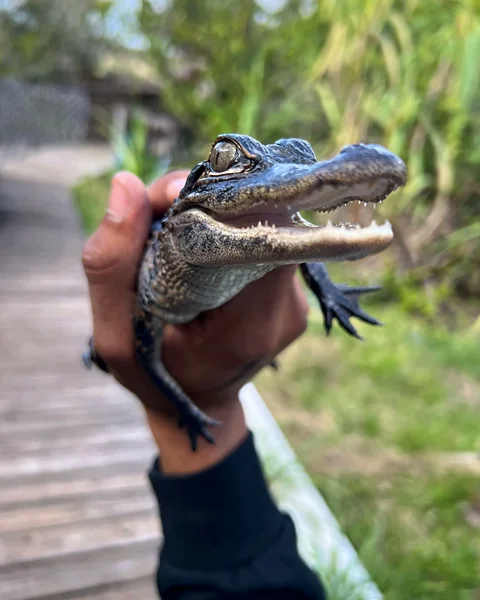 Hector Tigertail
Hector TigertailMurray hopes his forthcoming research can provide further evidence about the value of supporting healthy alligator populations. Although hunting bans were the most important step to save the species from extinction, efforts to protect and restore populations are ongoing and involve groups who are often less recognised, he says. Among them are commercial alligator ranchers who retrieve eggs from the wild, incubate them and raise them through the first few years of life in enclosed or semi-wild environments, safeguarding them when they are most vulnerable to predation and disease. This form of early-years care, known as "head-starting", is common in conservation initiatives that aim to help endangered animals – from Eastern indigo snakes to burrowing owls. But, in Louisiana, this is a "self-funded" system driven by ranchers, says Murray. These ranchers are required to release 5% of alligators they raise into the wild, while the rest are treated as livestock that can be butchered for meat and hides.
In the Everglades, head-starting is also carried out by the Miccosukee, who rescue eggs in years when water levels in the Everglades rise, threatening to drown eggs, or temperatures fall to levels that can harm baby alligators. "Sometimes I would be at home and my uncle would tell me: 'Hey, the temperature is dropping really fast. It's going to be a really cold night. So get on the airboat and we have to go out there before the cold weather kills them'," says Tigertail.
Despite their fearsome reputation, all this hints at a future where humans and alligators coexist, with these reptiles recognised as "helpful participants" in solutions to the challenges we both face, says Murray. "If you think historically, alligators and other crocodilians have been revered as a sacred entity in cultures around the world. Do they command respect? Yes. But are they monsters? Are they to be feared? No."
--
For essential climate news and hopeful developments to your inbox, sign up to the Future Earth newsletter, while The Essential List delivers a handpicked selection of features and insights twice a week.
